Top 7 UI/UX Design Courses to Elevate Your Skills - UI/UX
Top 7 UI/UX Design Courses to Elevate Your Skills
In a competitive digital marketplace, a seamless user experience (UX) and an intuitive user interface (UI) are no longer optional. They are the bedrock of successful mobile applications and websites. For aspiring designers and seasoned professionals alike, mastering these skills is crucial for creating products that engage and retain users. At App Developer UK, we specialise in crafting high-performance apps with Google's Flutter, a framework where exceptional UI/UX is paramount for creating fluid, natively compiled experiences that delight users. We recognise that great app development starts with a foundation of great design.
But with countless UI/UX design courses available, how do you find the one that aligns with your career goals, learning style, and budget? This guide is designed to cut through the noise. We have meticulously curated a list of the top seven UI/UX design courses for 2025. Each entry provides a detailed breakdown of its unique strengths, costs, formats, and ideal target audience. Our goal is to equip you with clear, actionable information, including direct links and platform insights, so you can confidently select the right programme to advance your skills and unlock your design potential.
1. Coursera (incl. Google UX Design Professional Certificate)
Coursera stands out in the online learning landscape by offering a vast catalogue of UI/UX design courses from globally recognised universities and industry giants. It’s an ideal platform for learners seeking a structured, academic approach to design education, combining theoretical knowledge with practical, hands-on projects that build a job-ready portfolio. The platform’s flexible, self-paced model allows you to learn around your existing commitments.
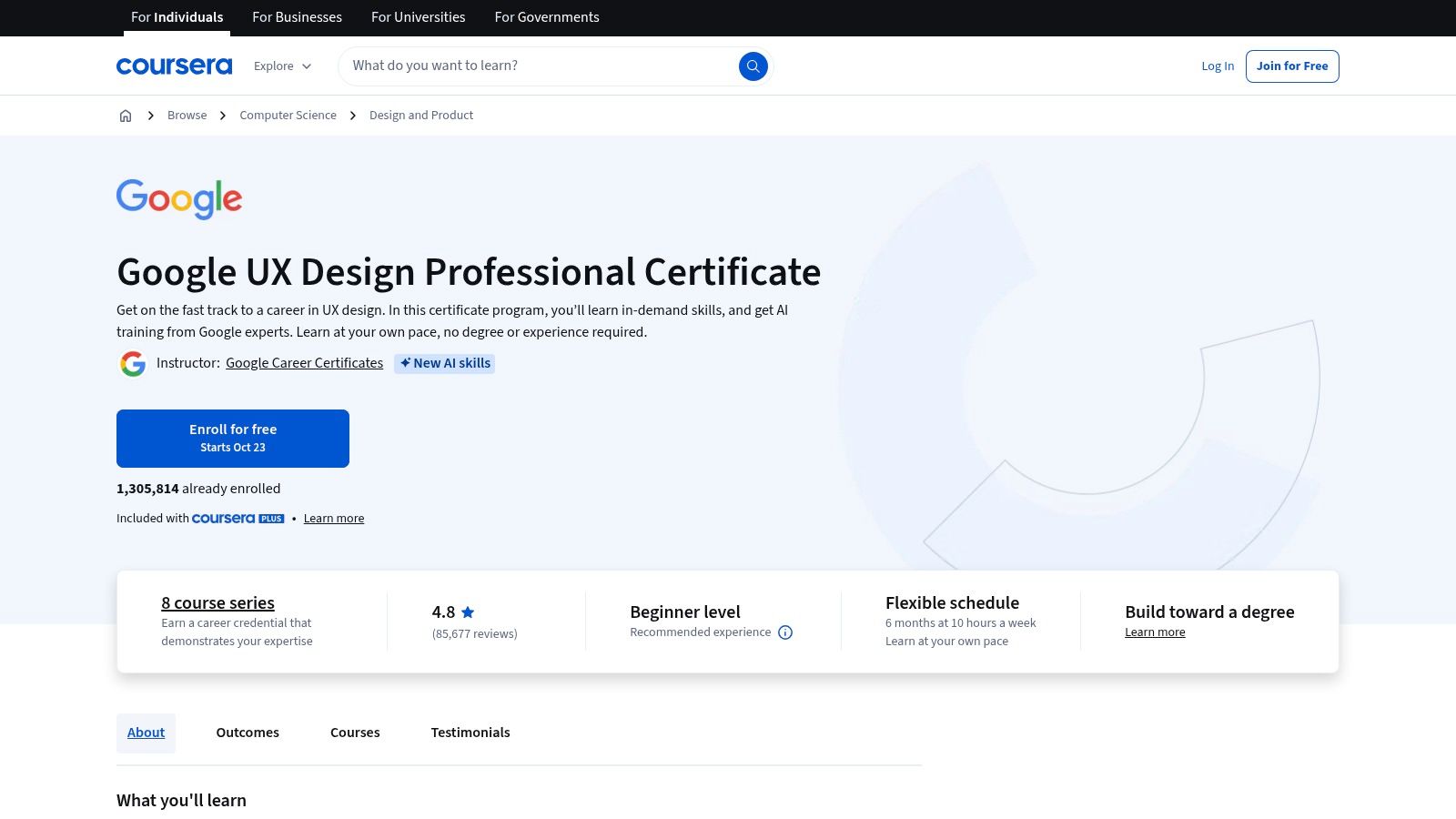
The flagship offering for aspiring designers is the Google UX Design Professional Certificate. This multi-course programme is designed to take beginners from foundational principles to professional-level skills in under six months. It covers the entire design process, including empathising with users, defining pain points, ideating solutions, and creating wireframes, mockups, and prototypes in tools like Figma and Adobe XD. A key part of the certificate involves completing three end-to-end projects, including a mobile app, a responsive website, and a cross-platform experience.
Key Features and Offerings
Coursera’s strength lies in its blend of quality content and practical application. The Google certificate, for example, is not just about watching videos; it involves graded assignments, peer feedback, and portfolio-building activities that are crucial for landing a job. One of the projects focuses heavily on creating a mobile-first experience, where you'll apply principles of adaptive layouts. Understanding how to design for different screen sizes is essential, as explained in this guide on what is responsive design, a skill highly valued by employers.
Access and Cost:
- Model: Subscription-based (Coursera Plus) or individual certificate purchase.
- Price: A Coursera Plus subscription, which includes the Google certificate and thousands of other courses, typically costs around £48 per month or £316 per year. Financial aid is also available.
- Best For: Beginners wanting a structured, comprehensive curriculum from an industry leader.
Website: Coursera Google UX Design Certificate
2. FutureLearn
FutureLearn offers a distinct, UK-centric approach to online learning, making it an excellent choice for learners seeking UI/UX design courses from well-regarded British universities and professional institutions. Its model is built around accessibility and flexibility, featuring a mix of short, specialised courses and more in-depth programmes. The platform excels at fostering a collaborative environment through discussion-led learning, encouraging interaction between students and educators.
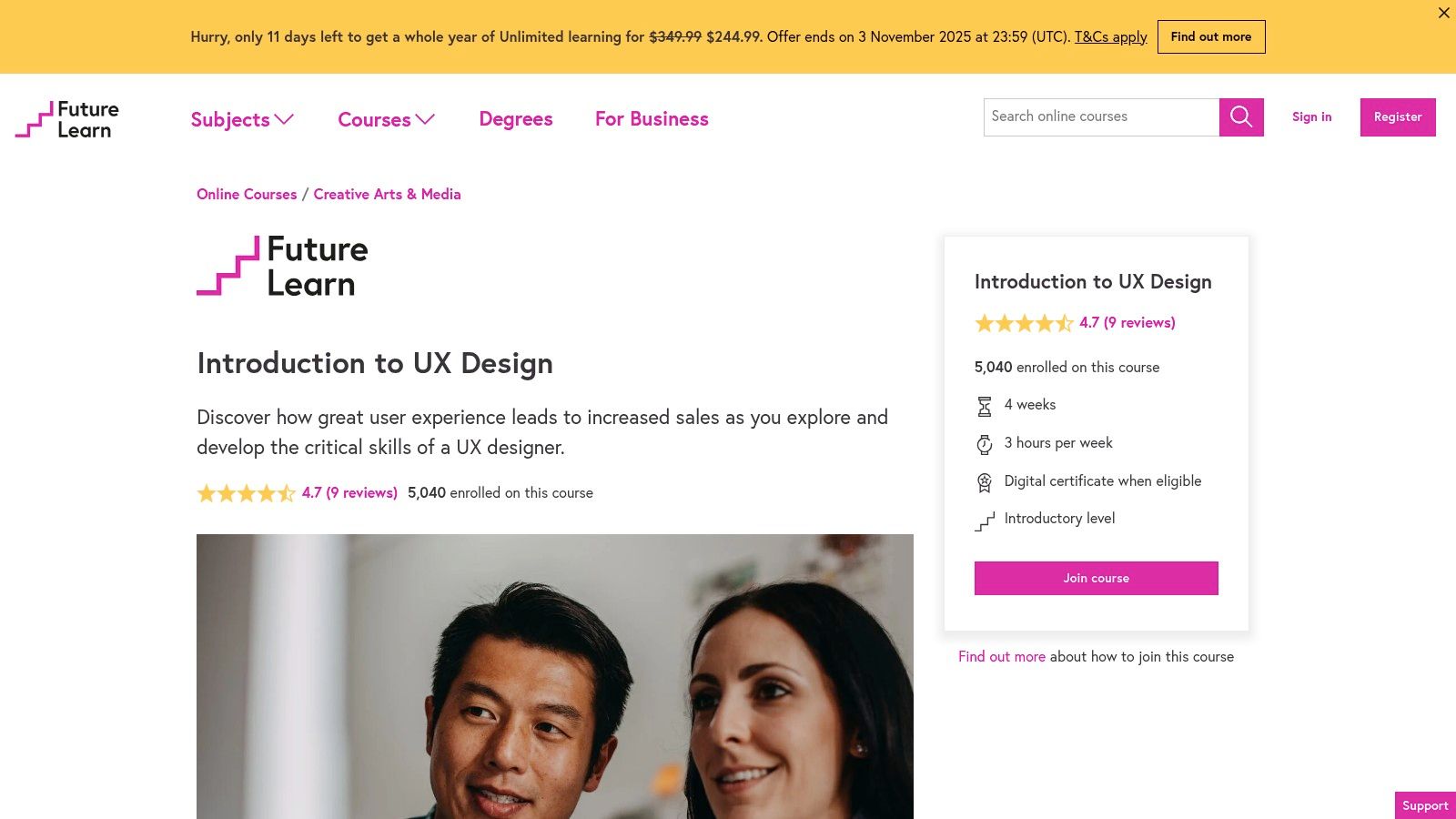
One of its key offerings is the User Experience (UX) Design course from Accenture, which provides a solid introduction to the core principles of UX. This course is designed to be highly practical, guiding learners through the entire design thinking process, from user research and persona creation to wireframing and prototyping. Unlike some platforms that focus solely on individual projects, FutureLearn’s cohort-style progression encourages peer discussion at every step, creating a more dynamic and engaging educational experience.
Key Features and Offerings
FutureLearn’s strength lies in its transparent access model and focus on specific, targeted skills. The platform's courses often emphasise real-world application, ensuring that the theoretical concepts are directly tied to practical outcomes. For instance, learners will explore how to conduct effective user research and translate those findings into actionable design decisions, a foundational skill for any UX professional. The emphasis on UK-based institutions also provides a valuable local context for learners in the region.
Access and Cost:
- Model: Offers several tiers, including a free 'taster' access, one-off purchases for lifetime access and a certificate, or an annual 'Unlimited' subscription.
- Price: Individual course upgrades typically range from £30 to £70. The FutureLearn Unlimited subscription costs around £199.99 per year, granting access to most short courses.
- Best For: Learners in the UK seeking short, focused courses for upskilling or beginners wanting a low-commitment entry point.
Website: FutureLearn User Experience Design
3. General Assembly London
General Assembly (GA) is a global education company renowned for its intensive, career-focused bootcamps, and its London campus offers a premier pathway into the UK tech industry. Unlike self-paced online platforms, GA provides immersive, cohort-based UI/UX design courses designed to transform beginners into job-ready professionals. This model is ideal for learners seeking a structured, high-accountability environment with direct access to expert instructors and a strong peer network.
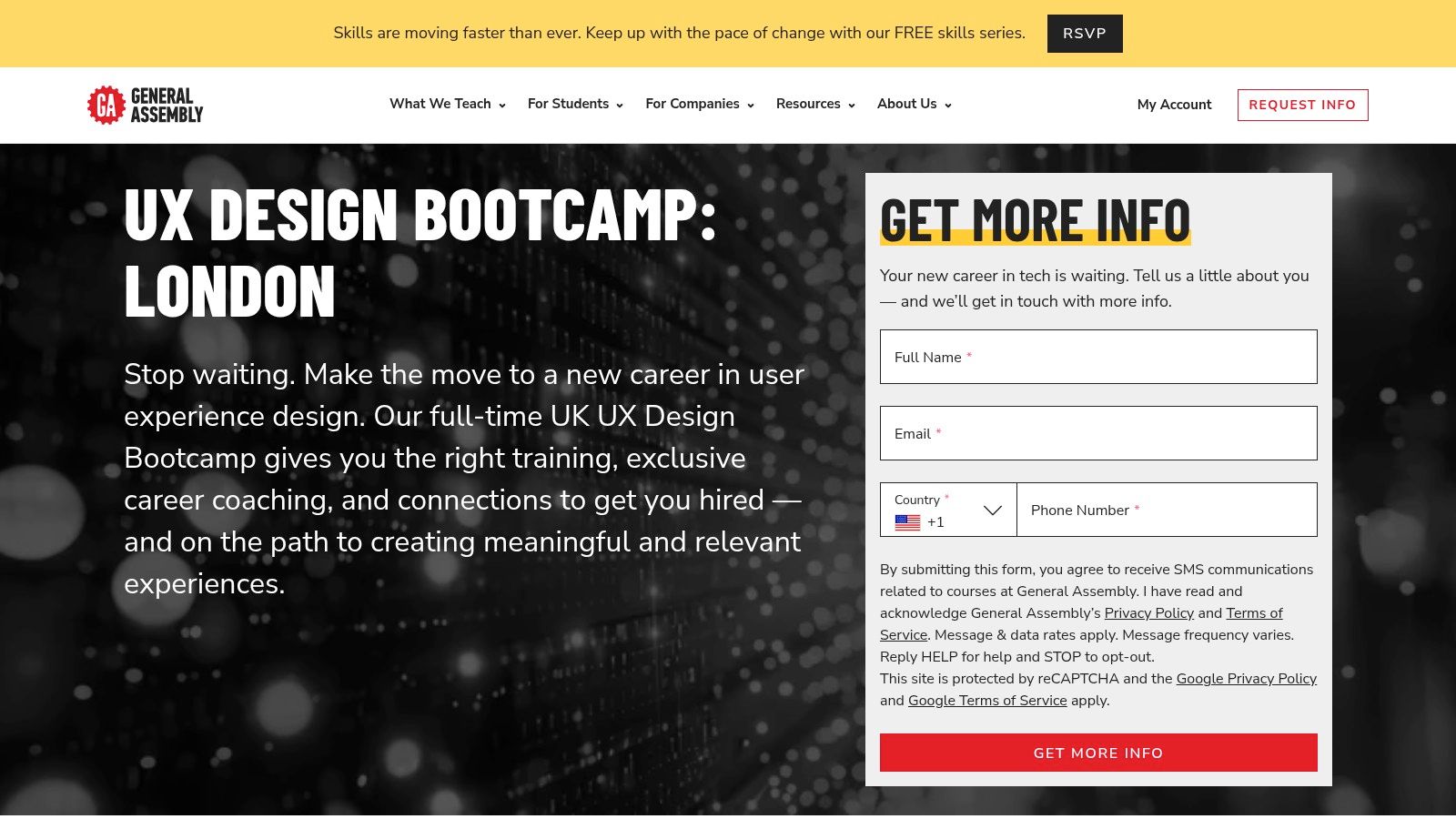
The flagship UX Design Immersive is a full-time, 12-week programme that covers the entire design lifecycle, from user research and journey mapping to wireframing, prototyping, and usability testing. A key differentiator is its emphasis on employer-aligned skills and portfolio development. Students work on several real-world projects, culminating in a professional-grade portfolio to showcase to potential employers, a crucial asset for anyone entering the competitive field of UK user experience design services.
Key Features and Offerings
General Assembly’s strength lies in its comprehensive career support and real-world project focus. The bootcamp isn't just about learning theory; it’s about applying it. Students collaborate on client projects, receive one-on-one mentorship, and get dedicated support with CV writing, interview preparation, and networking within GA’s extensive employer network. The curriculum is constantly updated to reflect current industry demands, ensuring graduates possess relevant, marketable skills. For those unable to commit to a full-time schedule, GA also offers shorter, part-time courses covering specific UX/UI topics.
Access and Cost:
- Model: Immersive bootcamps (full-time) and part-time courses, available in-person in London or live online.
- Price: The UX Design Immersive is a significant investment, typically costing around £11,000. GA offers multiple UK-specific payment plans, including interest-free instalments, loans, and scholarships to improve accessibility.
- Best For: Career changers and serious beginners seeking an intensive, fast-tracked route into a UX design career with robust job support.
Website: General Assembly UX Design Bootcamp London
4. The School of UX
The School of UX offers a distinctly practical, hands-on approach to learning, making it a superb choice for individuals who thrive in interactive, instructor-led environments. This UK-based provider specialises in short, intensive UI/UX design courses and longer bootcamps, available both in-person in London and live online. Its model is built around small-group learning, ensuring learners get direct feedback and mentorship while working on real-world exercises.
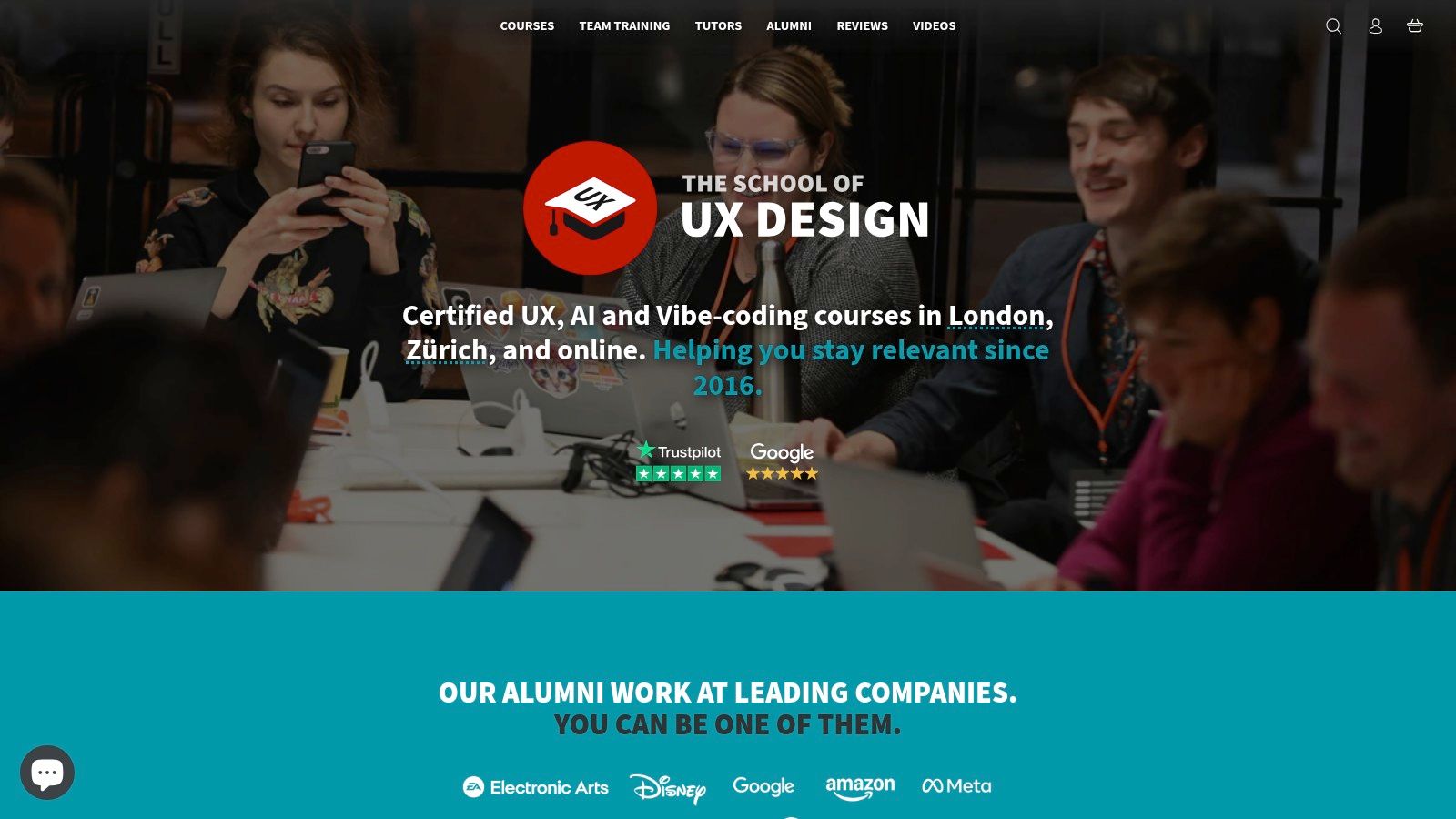
Unlike massive online platforms, The School of UX focuses on depth and direct application over a broad catalogue. Courses typically run from 3 to 5 days, covering everything from user research and wireframing to prototyping in Figma and incorporating AI-assisted workflows. For those seeking a more immersive experience, multi-week Skills Bootcamps are available. A significant advantage for UK residents is that some of these bootcamps are eligible for government funding, making high-quality training more accessible.
Key Features and Offerings
The core strength of The School of UX is its emphasis on doing, not just watching. Each course is packed with practical exercises designed to build your skills and confidence rapidly. The curriculum includes dedicated portfolio mentoring, helping you translate your classwork into a compelling showcase for potential employers. The small-group format fosters a collaborative atmosphere where you can receive personalised instructor feedback, a crucial element for refining your design thinking and technical abilities. This focused, practical training ensures you gain relevant skills quickly.
Access and Cost:
- Model: Direct purchase of short courses or multi-week bootcamps.
- Price: Short courses start from around £995, while bootcamps vary. Some multi-week Skills Bootcamps offer government-funded places for eligible UK residents.
- Best For: Learners preferring hands-on, instructor-led training in small groups with clear, practical outcomes.
Website: The School of UX
5. Interaction Design Foundation (IxDF)
The Interaction Design Foundation (IxDF) is a highly respected online design school with a non-profit ethos, offering an extensive library of self-paced UI/UX design courses. It’s structured like a Netflix for design education; one annual membership fee grants you unlimited access to their entire catalogue. This makes it a uniquely cost-effective option for designers committed to continuous, long-term learning rather than just a single, intensive bootcamp.
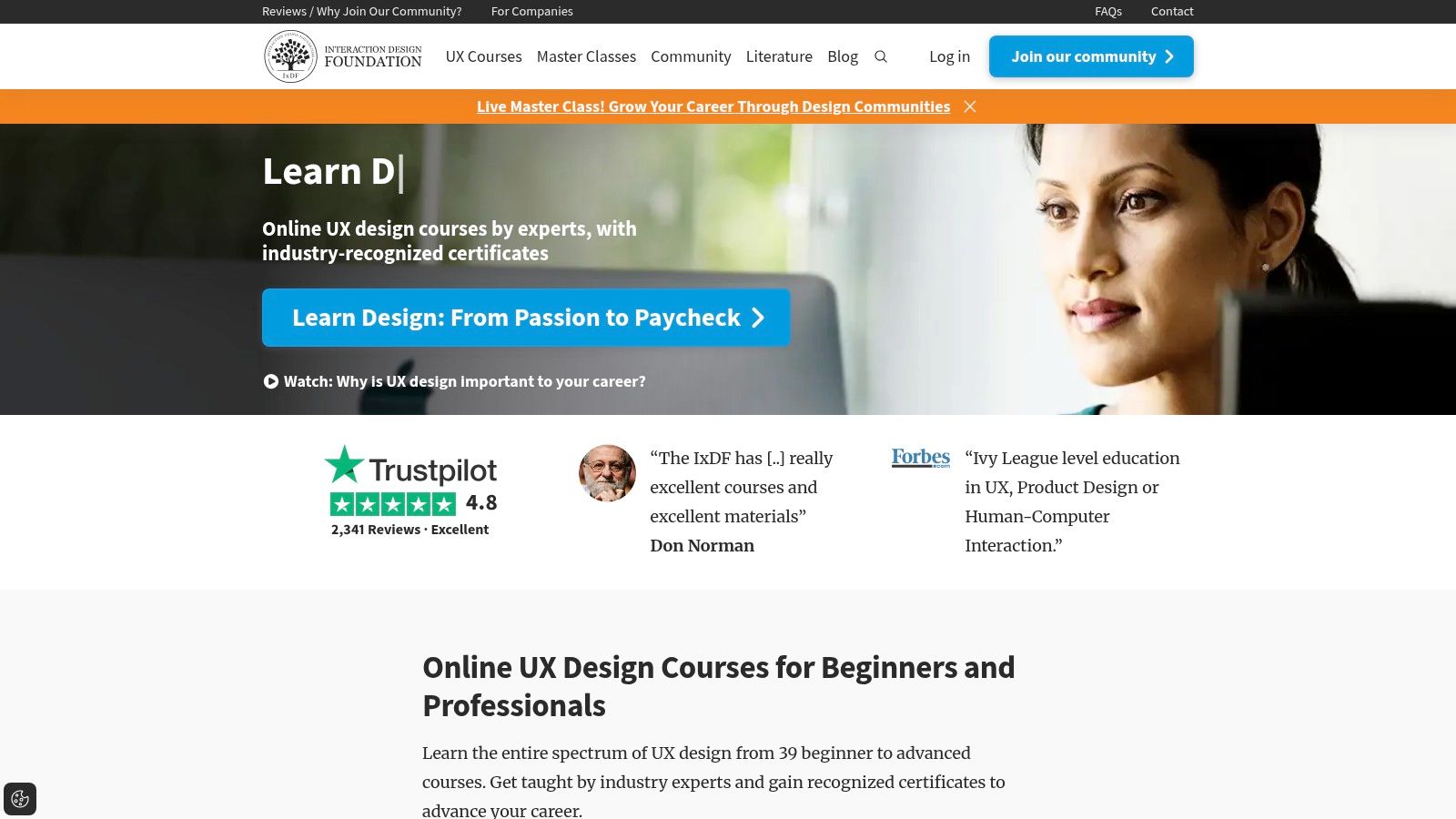
Unlike platforms focused on a single certificate path, IxDF allows you to create your own learning journey. You can dive deep into specific topics like user research, accessibility, information architecture, or visual design, earning individual certificates for each course you complete. The content is developed in collaboration with industry experts and academics, ensuring a strong foundation in both established design theory and modern, practical application. The active global community and regular webinars add another layer of value, connecting learners with peers and mentors.
Key Features and Offerings
IxDF’s primary strength is its sheer breadth and depth of content. With over 30 courses covering everything from foundational design thinking to advanced user psychology, it caters to both newcomers and seasoned professionals looking to specialise. The platform's self-paced nature provides ultimate flexibility, though it requires self-discipline to progress without the rigid structure of a cohort-based programme. The focus on theoretical understanding alongside practical skills helps build well-rounded designers who know not just how to do something, but why.
Access and Cost:
- Model: Annual membership-based subscription.
- Price: Professional membership costs around £156 per year, granting access to all courses and the community. Note that billing is annual, and some users have noted the auto-renewal process requires attention.
- Best For: Self-motivated learners and professionals seeking continuous, in-depth education at an affordable price.
Website: Interaction Design Foundation
6. Nielsen Norman Group (NN/g) UX Training and Certification
Nielsen Norman Group (NN/g) is the gold standard for professionals seeking deep, evidence-based UX education. Co-founded by usability pioneer Don Norman, NN/g provides premium, research-backed training delivered through live virtual and in-person conferences. This platform is less for beginners and more for practising designers, researchers, and product managers who want to elevate their skills with rigorous, science-driven methodologies and earn a highly respected industry credential.
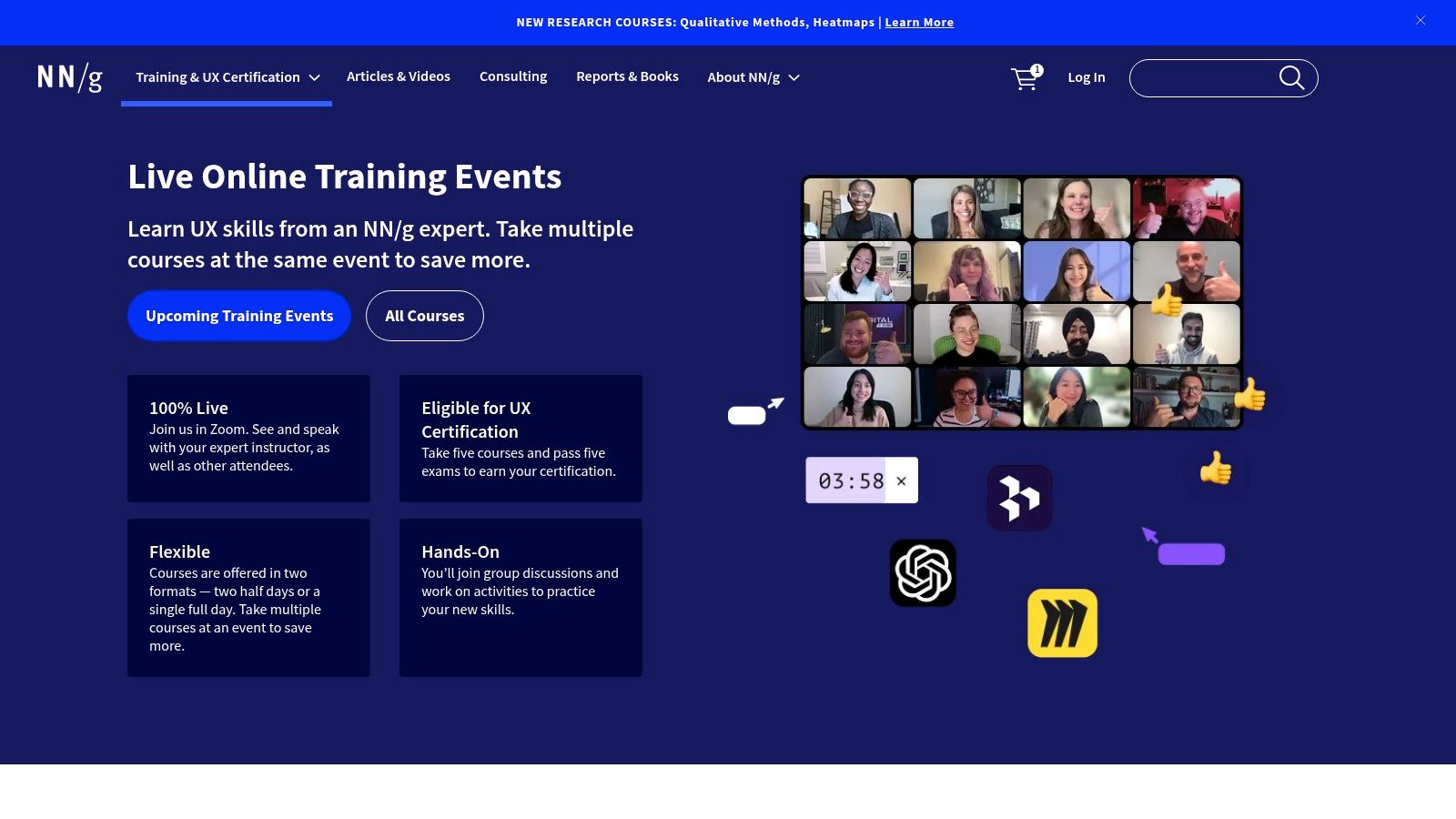
Unlike self-paced video libraries, NN/g’s model is built around intensive, full-day or half-day live courses. Learners can select individual courses on specialised topics or attend a series of five to earn the NN/g UX Certification. Each course is followed by an exam to test comprehension and application. This structure ensures that participants not only absorb the information but can also apply it, making the certification a meaningful indicator of expertise. The focus is on foundational principles that transcend specific tools or trends.
Key Features and Offerings
The primary strength of NN/g is its unparalleled authority and research-backed content. The courses cover a vast range of topics, from user research and interaction design to information architecture and UX management. This depth is critical for building robust, user-centric products; a poorly designed interface can have a significant negative impact, as detailed in this guide on how app design could be costing you customers. Earning the UX Certification or the advanced UX Master Certification is a significant career achievement.
Access and Cost:
- Model: Per-course or conference pass purchase for live training (virtual or in-person).
- Price: Premium pricing reflects the calibre of instruction. Individual courses typically start from around £800-£900, with a full five-course certification track costing several thousand pounds.
- Best For: Experienced UX professionals seeking to deepen their expertise with world-renowned, research-based training and a prestigious certification.
Website: Nielsen Norman Group Training
7. LinkedIn Learning (formerly Lynda.com)
LinkedIn Learning, the successor to the highly respected Lynda.com, functions as an extensive on-demand digital library for professional development. For UI/UX design, it offers a vast collection of bite-sized videos and structured learning paths, making it an excellent resource for professionals looking to upskill, fill specific knowledge gaps, or explore new tools without committing to a long-term, intensive programme. Its strength lies in its breadth and accessibility, especially for those who already have access through corporate, academic, or public library memberships.
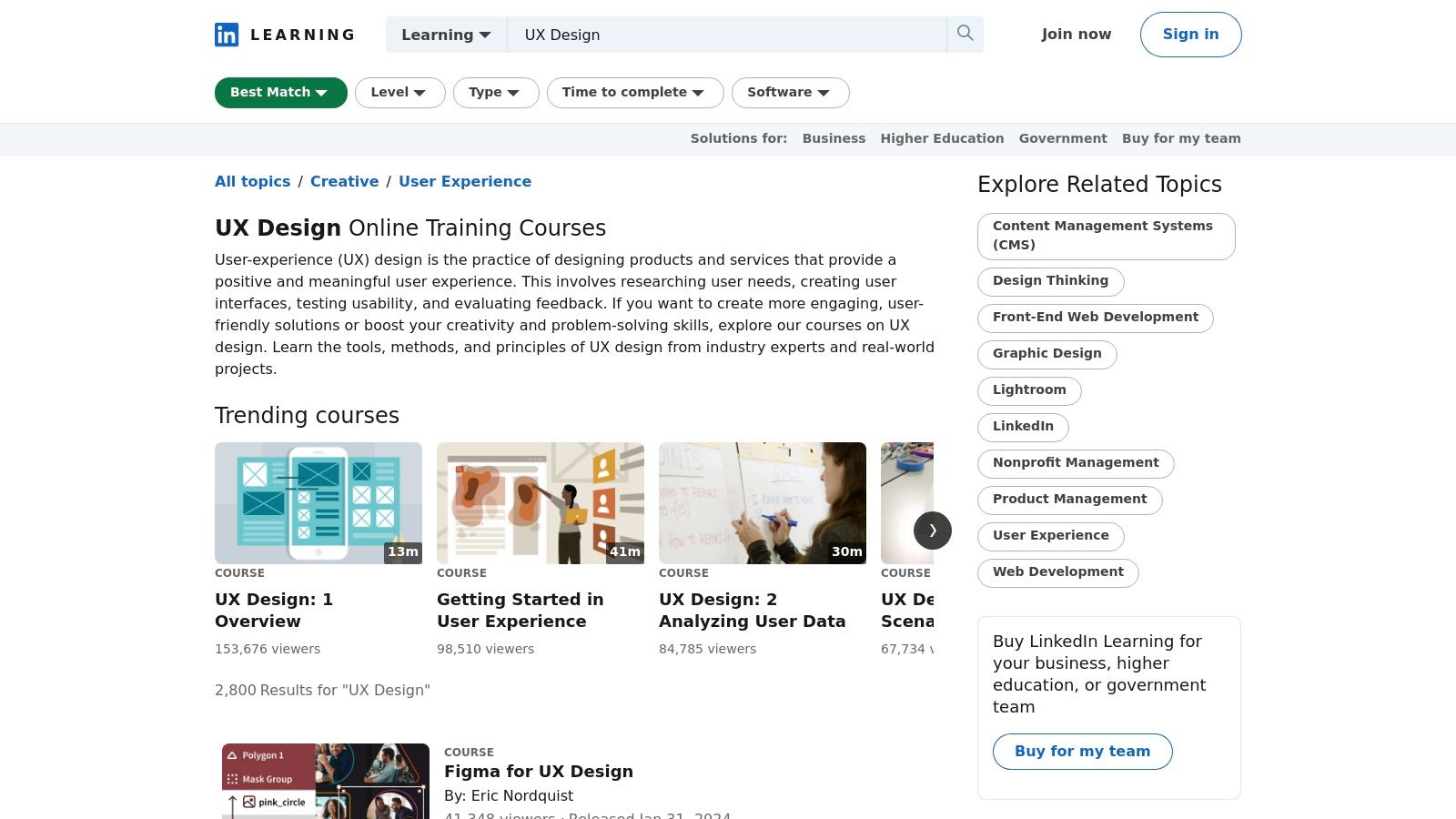
The platform curates content into Learning Paths such as "Become a UX Designer," which organises a series of individual courses into a logical sequence. These paths guide learners through foundational concepts, design thinking, user research, and software proficiency in tools like Figma and Adobe XD. Unlike cohort-based bootcamps, LinkedIn Learning allows users to dip in and out of topics as needed, making it ideal for targeted learning. For instance, you could quickly watch a short course on prototyping for a mobile app project one day and another on user journey mapping the next.
Key Features and Offerings
LinkedIn Learning stands out for its flexibility and the sheer volume of high-quality, professionally produced courses. The content is delivered by industry experts and includes downloadable exercise files, quizzes to test your understanding, and certificates of completion that can be added directly to your LinkedIn profile. While these certificates may not carry the same weight as a formal certification, they effectively signal a commitment to continuous learning to potential employers. The platform is particularly useful for mastering specific aspects of UI/UX, such as designing interfaces for cross-platform applications built with powerful frameworks.
Access and Cost:
- Model: Monthly or annual subscription. Often included with employer, university, or public library memberships.
- Price: A standalone subscription typically costs around £34.99 per month or £239.88 per year, often with a one-month free trial.
- Best For: Self-directed learners and professionals needing to quickly fill specific skill gaps or sample a wide range of topics.
Website: LinkedIn Learning UX Design
Top 7 UI/UX Courses Comparison
| Provider | 🔄 Complexity | ⚡ Resources & Cost | ⭐ Expected outcomes | 📊 Ideal use cases | 💡 Key advantages |
|---|---|---|---|---|---|
| Coursera (incl. Google UX Design) | 🔄 Moderate — structured, multi-course, self-paced | ⚡ Low–Moderate — subscription or per-course; financial aid | ⭐ Portfolio projects, beginner→intermediate competence; recognised certs | 📊 Career starters seeking guided, project-based learning | 💡 Recognisable providers; updated content; flexible pacing |
| FutureLearn | 🔄 Low — short, cohort-led courses | ⚡ Low — transparent per-course pricing or annual Unlimited | ⭐ Short-term skill gains and certificates | 📊 Quick upskilling with UK-relevant content | 💡 Clear pricing tiers; cohort discussion format |
| General Assembly London | 🔄 High — immersive bootcamps, cohort schedule | ⚡ High — premium tuition; instalments & scholarships available | ⭐ Career-ready portfolio and employer-aligned skills | 📊 Intensive career pivots; in-person London or live online | 💡 Strong career support, mentorship and hiring links |
| The School of UX | 🔄 Moderate — small-group live sessions, hands-on | ⚡ Low–Moderate — short intensives to multi-week; some funded spots | ⭐ Practical, tool-focused skills and portfolio feedback | 📊 Short intensives or small-group instructor-led practice | 💡 Small cohorts, Figma/AI workflows, potential gov't funding |
| Interaction Design Foundation (IxDF) | 🔄 Low — self-paced membership access to many courses | ⚡ Very cost-effective — annual membership covers library | ⭐ Broad theoretical + practical grounding; course certs | 📊 Continuous learners seeking breadth and steady progress | 💡 Large library, active community, good value for ongoing learning |
| Nielsen Norman Group (NN/g) | 🔄 High — live, evidence-based courses with exams | ⚡ High — premium pricing; travel may be required | ⭐ Senior-level, research-backed expertise; recognised credential | 📊 Experienced professionals seeking deep, rigorous training | 💡 Highly respected credential and rigorous standards |
| LinkedIn Learning | 🔄 Low — bite-sized, on-demand courses | ⚡ Low — subscription; often available via employer/library | ⭐ Quick skill fills; certificates of completion (less depth) | 📊 Sampling topics and tool-specific upskilling | 💡 Broad library, consistent production quality, easy access |
From Learning to Launching: Your Next Steps in UI/UX
Embarking on any of the ui/ux design courses we've explored is a powerful commitment to your professional development. We have navigated a diverse landscape, from the comprehensive, industry-recognised Google UX Design Professional Certificate on Coursera to the highly specialised, research-backed training from the Nielsen Norman Group. Whether you prefer the flexible, self-paced learning offered by FutureLearn and LinkedIn Learning or the intensive, hands-on bootcamps at General Assembly London, there is a pathway perfectly suited to your goals, budget, and learning style.
The key takeaway is that no single course is universally "the best"; the ideal choice is entirely dependent on your individual circumstances. Your decision-making process should be a strategic reflection of your career ambitions.
How to Choose Your Ideal Course
To crystallise your decision, consider these critical factors:
- Career Goals: Are you aiming for an entry-level position, a career change, or are you looking to specialise in a niche like user research or interaction design? A comprehensive programme like General Assembly might suit a career changer, while a specialist course from IxDF could be ideal for upskilling.
- Time Commitment: Be realistic about the hours you can dedicate. A full-time bootcamp requires a significant life adjustment, whereas platforms like Coursera and FutureLearn offer the flexibility to learn around your existing commitments.
- Budget: Your financial situation is a major factor. Free or low-cost options on LinkedIn Learning are excellent starting points, while an investment in a NN/g certification can deliver a substantial long-term return through industry prestige and deep expertise.
- Learning Style: Do you thrive in a collaborative, instructor-led environment, or do you prefer to absorb information independently? Your answer will guide you toward either a structured bootcamp or a self-directed online course.
Putting Your New Skills into Practice
Completing one of these top-tier ui/ux design courses provides you with a robust theoretical foundation and a set of practical skills. However, the true test begins when you apply this knowledge to real-world projects. A certificate is your entry ticket, but a strong, diverse portfolio is what will truly set you apart and open doors to exciting opportunities.
As you start building case studies, remember that design principles are universal, but their implementation is what creates exceptional user experiences. In today's mobile-first world, the technology you design for is just as important as the design itself. Frameworks like Flutter are increasingly becoming the go-to choice for bringing ambitious UI/UX visions to life. Its ability to create high-fidelity, natively compiled applications for mobile, web, and desktop from a single codebase is a game-changer.
Recent performance benchmarks consistently place Flutter at the forefront, enabling the creation of fast, responsive, and visually stunning applications. This makes it a perfect canvas for designers to exercise their skills without technical limitations, ensuring that the final product looks and feels exactly as intended. For any aspiring UI/UX designer, understanding the capabilities of such powerful frameworks is a significant advantage.
Ready to transform your polished UI/UX designs into a high-performance, market-ready mobile application? At App Developer UK, our team specialises in Flutter development, working closely with designers to build beautiful, functional, and user-centred apps. Let us be the expert development partner that brings your creative vision to life.